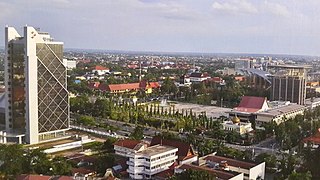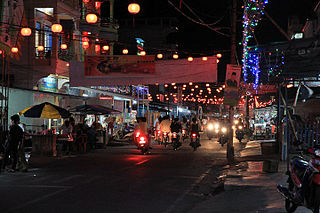Variations
Certain names have variations in different languages. Oor/Ooru is a common Proto Tamil name which means a place, also known as Oor in Tamil and Malayalam, whereas it is called Ooru in Telugu and Kannada.
Andhra Pradesh and Telangana
Common suffixes include, -ooru, -palli, -pudi, -peta, etc.
| Suffix | Meaning | Etymology | Examples |
|---|
| -abad | city | Urdu آباد < Persian ـآباد/آباد < Middle Persian ʾp̄ʾt' (ābād, “populous, thriving, prosperous”). < Proto-Iranian *āpāta-, < Proto-Indo-European *peh₂- (“to protect”) | Hyderabad, Secunderabad, Nizamabad |
| -bagh | town | Urdu باغ ("garden") < Persian باغ bâğ < Middle Persian 𐭡𐭠𐭢 (bāɣ, “garden, orchard”) < Proto-Indo-Iranian *bʰāgá- (“portion, share, allotment”) < Proto-Indo-European *bʰeh₂g- (“to divide, distribute, allot”) | Suryabagh, Nausena Baugh |
| -cherla | town | Telugu చర్ల (charla "town") | Macherla, Chengicherla |
| -guda/-gudem/-gudemu | village | Telugu గూడ (gūḍa "village. hamlet") < Telugu గూడెం (gūḍem) గూడెము (gūḍemu) | Tadepalligudem, Galigudem, Dumbriguda |
| -kot/-kota | fort | Telugu కోట (kōṭa "fort, fortress") < Proto Tamil *kōṭṭay ("fort, castle). | Samalkot, Kasimkota, Sriharikota |
| -nagar/-nagaram/-nagaru | town | Telugu నగర్ (nagar), నగరం (nagaraṁ), నగరు (nagaru) < Proto Tamil *nakar ("town, city"). [4] | Karimnagar, Mahabubnagar, Vizianagaram, |
| -ole/-olu | town | Anglicized Telugu -ole < Telugu ఓలు (ōlu "town") < Old Telugu ప్రోలు (prōlu "city, town") | Ongole, Nidadvolu |
| -ooru/-oor/-ore/-ur/-uru | village | Anglicized Telugu -ore < Telugu ఊరు (ūru "village") < Proto Tamil *ūr ("village, habitation") | Guntur, Nellore, Chittoor, Eluru, Anantapur |
| -palem/-palemu/-palle/-pallem/-pallemu/-palli | village | Telugu పాలెం (pāleṁ), పాలెము (pālemu), పల్లె (palle), పల్లెం (palleṁ), పల్లెము (pallemu) < Telugu పల్లి (palli "village") పల్లీ (pallī "village") < Proto-Tamil*paḷḷi ("(small) village") [4] | Peddapalli, Madanapalle, Nadimpalle |
| -patnam/-patnamu | port city | Telugu పట్నం (paṭnaṁ "patnam") < Tamil*pattinam ("port town") | Vishakhapatnam, Machilipatnam, Krishnapatnam |
| -pedu | | | Yerpedu |
| -pudi | village | (Old?) Telugu పుడి (pudi "village") | Kuchipudi |
| -pur/-puram/-puramu/-puri | city | Telugu పూర్ (pūr) పూరం (pūraṁ) పూరము (pūramu) పూరి (pūri) < Sanskrit पुर (pura) < Proto-Indo-European *pl̥h₁- (“stronghold”) | Markapur, Hindpur, Atchutapuram |
| -put/-puttu | village | Telugu పుట్టు (puṭṭu "village, put") < Proto-Dravidian (?) | Manchingiput, Jalaput, |
| -seema | region | Telugu సీమ (sīma "region, kingdom") < Sanskrit सीमा (sīmā "border, region") | Rayalaseema |
| -vada/-wada | area, place | Telugu వాడ (vāḍa "area, place") | Vijayawada, Vemulawada |
| -vaka/-waka | town | Telugu వాక (vāka "town") | Gajuwaka, Hanumanthavaka |
| -valasa | town | Telugu వలస (valasa "town, migration") | Thangarapuvalasa, Palavalasa |
Arunachal Pradesh
Namdapha National park, Roing, Tezu, Sakteng Wildlife sanctuary, Namsai, Parsurum Kund, Bhairabkunda, Khonsa, Jairampur, Bhismaknagar, Changlang, Hawai, Nampong, Koloriang, etc. [5]
Assam
| Suffix | Meaning | Etymology | Examples |
|---|
| -gā̃o | village | Sanskrit (ग्राम, grāma) | Bongaigaon, Chaygaon, Morigaon, Nagaon |
| -hāṭ/hāṭī | market | Sanskrit (हाट, hāṭa) | Guwahati, Jorhat, Moranhat |
| -pāṛā | neighbourhood | Sanskrit (पद्र, padra) | Bilasipara, Goalpara, Rangapara |
| -pur | settlement | Sanskrit (पुर, pura) | Badarpur, North Lakhimpur, Tamulpur, Tezpur |
Bihar
Bodh Gaya, Patna, Rajgir, Gaya, Raxaul, Muzaffarpur, Darbhanga, Pawapuri, Sasaram, Hajipur, Bihar Sharif, Kesaria, Sonpur, Munger and Bhagalpur Division.
Chhattisgarh
Raipur, Jagdalpur, Bilaspur, Durg, Kanger Ghati National Park, Bhilai, Sirpur, Ambikapur, Korba, Kawardha, Raigarh, Dongargarh, Tirarthgar, Atal Nagar, Mainpat, Indravati National Park, Ratanpur, Rajim, Chitrakoot, Rajnandgaon, Dhamtari, Kanker and Champa.
Delhi
New Delhi, Gurugram, Mehrauli, Karol Bagh, Delhi, Rohini, Chanakyapuri, Sonipat, Dwarka, Vasant Kunj, Pitam Pura, Bahadurgarh, Greater Kailash, Delhi Cantonment, Shahpur Jat, Shahdara, Najafgarh, Badarpurh, Nangloi Jat, Saidul Ajaib and Bawana.
Goa
Panaji, Calangute, Palolem Beach, Anjuna, Baga, Old Goa, Candolim, Margao, Vagator, Colva, Dona Paula, Vasco Da Gama, Mandrem, Morjim, Canacona, Mapusa, Arpora, Bogmalo Beach, Benaulim, Cavelossim, Ponda, Varca, Bardez, Majorda, Mobor, Dabolim, Agonda and Mormugao.
Gujarat
Common suffixes [6] | Suffix | Examples |
|---|
| -padra | Vaṭapadra, Vaḍapadra |
| -vadra | Jaravadra, Phalavadra |
| -pallī/-pallīkā | Ābhīrapallī, Āśāpallī |
| -valī/-valli/-vallikā | Kacchāvalī |
| -sthalī | |
| -hrada | |
| -draha | Vaṭa-draha |
| -sara | Jaṁbu-sara |
| -pāṭaka | Aṇahila-pāṭaka |
| -vāṭaka | |
| -ijya/-ijja | Avayānijya,, Karkijja |
| -vasaṇa | Caṇḍāvasaṇa |
| -vasahikā/-vāsaka | |
| -vāḍā | Ādhivāḍā |
| -vaḍa | |
| -pura/-purī/-nagara/-paṭṭana | Ānandapura, Nāndipurī, Girinagara |
| -siddhi/-sāḍhi | |
Jammu and Kashmir
Pangong Tso, Zanskar, Nyak Tso, Samba, Ramban, Khardong, Manikiala and Ranjit Sagar Dam Lake.
Jharkhand
Ranchi, Jamshedpur, Purulia, Deoghar, Dhanbad, Maithon, Hazaribagh, Netarhat, Bokaro Steel City, Ghatshila, Giridih, Rajmahal, Dumka, Parasnath Hill, Rajrappa, Medininagar, Patratu, Chaibasa, Panchet, Betla, Deoghar, Sahebganj, Pakur, Kodarma and McCluskieganj, Gumla.
Karnataka
Common endings are Ooru, Palaya, Halli, Pete, Seeme. Less common are prefixes such as Sri.
| Suffix | meaning | Common place names |
|---|
| Bhavi | well | Arabhavi, Sulibhavi, Bilebhavi, Nagarbhavi, Thondebhavi |
| Gud | habitation | Nanjangud, Handigud |
| Halli | village | Kanchamaranahalli, Arehalli |
| Keri | colony | Madikeri, Tallikeri |
| Kote | fort | Bagalakote, Jangamakote |
| Ooru/uru | village | Bengaluru, Mysuru, Mangaluru, Chikkamagaluru, Kitturu. Emmiganuru, |
| Pete | town | Chikkupete, Hosapete |
| Nagara | town | Vijayanagara, Jayaprakashanagara |
| Pura | city | Kundapura, Narasimharajapura, Kanakapura |
Kerala
Common suffixes include Angadi, Athani, Ur, Cheri/Shery, Kulam, Kad, Nad, Pally, Kode/Code, Kara, Mangalam, Kal, Puram, Kunnu, Parambu/Paramba and Puzha.
| Suffix | Meaning | Common place names |
|---|
| Ur | Shire | Nilambur, Tirur, Thrissur, Kannur, North Paravur. |
| Cheri/Shery | Street | Thalassery, Cherpulassery, Kalpakanchery, Manjeri, Thamarassery. |
| Nad | Village | Eranad, Kuttanad, Wayanad, Thondernad. |
| Kulam | Pond | Ernakulam, Kunnamkulam, Kayamkulam, Mararikulam, Mankulam, Unnikulam, Punnayurkulam, Muthukulam. |
| Angadi | Market Street | Parappanangadi, Tirurangadi, Pazhavangadi, Melangadi.- |
| Athani | Porter's rest | Athani, Puthanathani, Karinkallathani |
| Kad | Forest | Puthukkad, Purakkad, Thalakkad, Palakkad, Vadakkekad. |
| Kunnu | Hill | Kottakkunnu, Vallikkunnu, Konathukunnu, Kudappanakunnu, Pulinkunnoo. |
| Parambu/Paramba | Ground/Plot | Thaliparamba, Koothuparamba, Madathiparambu, Kizhuparamba, Thunchan Parambu. |
| Puzha | River | Alappuzha, Muvattupuzha, Thodupuzha, Cherupuzha, Noolpuzha. |
- Kode/Code - Kozhikode, Puthucode, Alamcode, Areekode, Veliyankode.
- Kara - Mavelikkara, Edakkara, Mullurkara, Anakkara, Ramanattukara.
- Mangalam - Kunnamangalam, Chathamangalam, Kunhimangalam, Chendamangalam, Enadimangalam.
- Pally - Karthikappally, Puthuppally, Kanjirappally, Vadanappally, Pulpally.
- Kal - Kottakkal, Chirakkal, Pothukal, Pulikkal, Edamulackal.
- Puram - Thiruvananthapuram, Malappuram, Angadipuram, Sivapuram, Kadampazhipuram.
Maharashtra
Common suffixes include Pur, Ner, Gav, Abad, Khed, Oli, Wadi, Nagar, Tur, Vali, and Ra.
- Pur - Nagpur, Solapur, Chandrapur, Kolhapur, Badlapur, Achalpur, Ballarpur, Pandharpur, Malkapur, Indapur, Jaysinghpur, Tulijapur, Murtijapur, Shirpur, Shirampur
- Ner - Sangamner, Jamner, Parner, Amalner, Saoner
- Gav - Jalgaon, Malegaon, Khamgaon, Kopargaon, Tasgaon, Majalgaon, Shegaon, Koregaon, Varangaon, Chalisgaon
- Abad - Aurangabad, Osmanabad, Khultabad, Dharmabad, Daulatabad
- Khed - Sindkhed, Jamkhed, Mudkhed, Narkhed, Gangakhed, Umarkhed
- Oli - Gadchiroli, Hingoli, Dapoli, Saoli, Sakoli, Wagholi, Biloli, Khopoli, Padoli
- Wadi - Hinjawadi, Vaibhavwadi, Kurduwadi, Sanaswadi, Sawantwadi, Wadi, Yewalewadi, Ghulewadi, Darewadi
- Nagar - Ahmednagar, Rajgurunagar, Ulhasnagar, Urjanagar, Shivajinagar
- Tur - Latur, Patur, Partur, Jintur
- Vali - Borivali, Kandivali, Karivali
- Ra - Bhandara, Rajura, Nandura
Manipur
Imphal, Loktak Lake, Moreh, Moirang, Ukrhul, Andro, Bishnupur, Shirui, Kakching, Churachandpur, Tamenglong, Thoubaul, Khangkhui, Jiribam, Leimaram, Khonghampat, Khongjom, Leimakhong, Tengnoupaul, Chandel, Kangpokpi, Senapati, Nambol, Nony, Jessami, Singda, Thanga and Khayang.
Mizoram
Aizawl, Lunglei, Champhai, Thenzhal, Murlen National Park, Serchhip, Murlen, Siaha, Kolasib, Hmuifang, Vairegte, Mamit, Saitual, Lengteng Wildlife Sanctuary, Zokhawthar, Baktawng, Farkawn, Phulpui, Sialsuk, Khawnlung, Tlabung, Lengpui and Ngengpui Wildlife Sanctuary.
Orissa
In Odisha (formerly known as Orissa) common suffixes are Pur, Garh, Gada.
Tamil Nadu
In Tamil Nadu, common suffixes are Oor, Nagaram, Puram, Kudi, Cheri, Paakkam, Pattinam, Palayam, Kaadu, Pettai, Mangalam, Seemai, naththam, palli and Kuppam. One common prefix is Thiru. The majority of names are in Tamil language. Telugu and Kannada place names can be seen in border areas. Sanskrit names are found because of the Aryans Modified Tamil Into sanscrit For ex: Sriperumbudur is Actually Thiruperumputhoor they sanscritized tamil
| Suffix | Meaning | Common Place names |
|---|
| Oor/ur/ore | Village | Ambattur, Thanjavur, Karur, Hosur, Tirupur, Coimbatore, Vellore. |
| Kaadu | Forest | Yercaud, |
| Pattinam | Coastal area | Nagapattinam |
| Puram | ectal | Kanchipuram, Ramanathapuram, Viluppuram |
| Nagaram | City | Vanagaram |
| Ni | bee | Theni |
| Kal | paving stone | namakkal |
| Kudi | settlement | karaikkudi, paramakudi, thoothukkudi |
|
Tripura
Common suffix include mura.
| suffix | meaning | common places |
|---|
| assa | | Ambassa, Bagbassa |
| bari | house | Churaibari, Jolaibari |
| chhara | stream | Laxmanchhara, Nabinchhara, Karaichhara, Bagaichhara, Dhanichhara, Sanichhara |
| mura | | Teliamura, Sonamura |
| pur | | Udaipur, Amarpur, Madhupur, |
| nagar | town or city | Ampinagar, Dharmanagar, Jubarajnagar |












